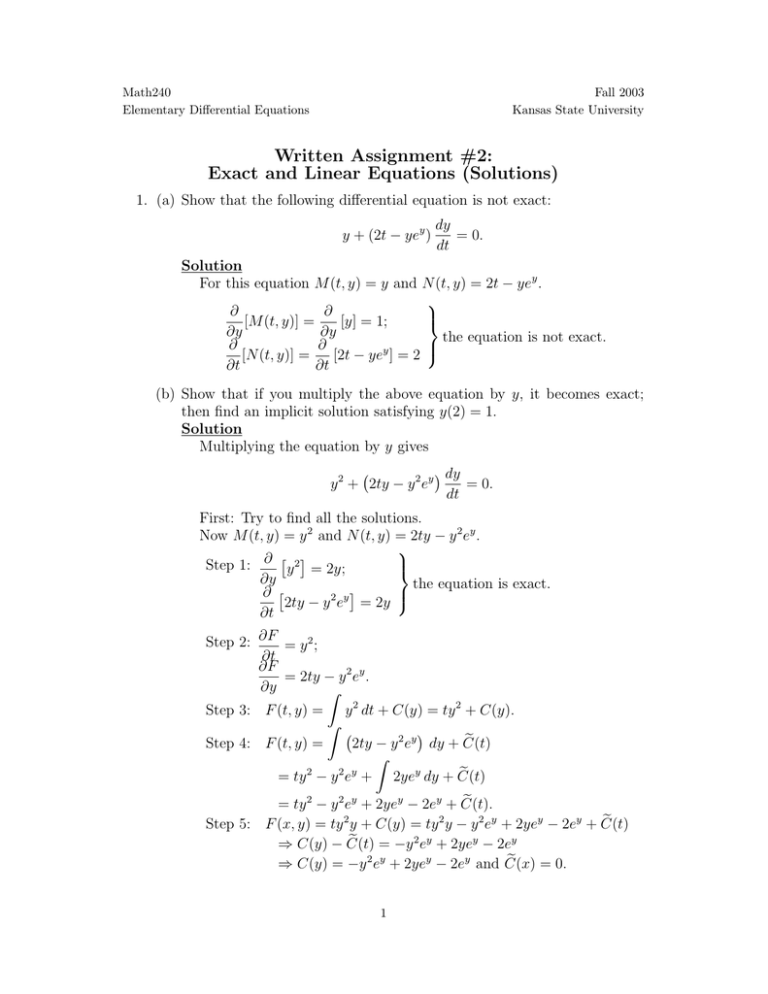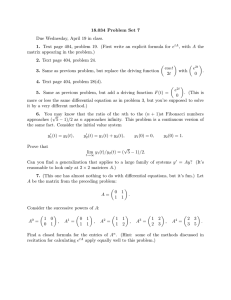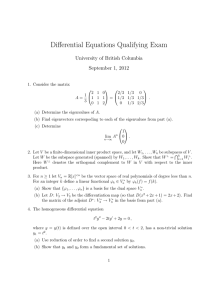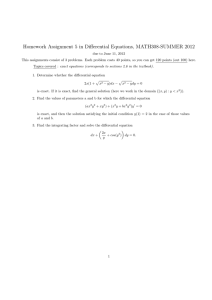Exact and Linear Equations
advertisement

Math240
Elementary Differential Equations
Fall 2003
Kansas State University
Written Assignment #2:
Exact and Linear Equations (Solutions)
1. (a) Show that the following differential equation is not exact:
y + (2t − yey )
dy
= 0.
dt
Solution
For this equation M (t, y) = y and N (t, y) = 2t − yey .
∂
∂
[M (t, y)] =
[y] = 1;
∂y
∂y
the equation is not exact.
∂
∂
[N (t, y)] =
[2t − yey ] = 2
∂t
∂t
(b) Show that if you multiply the above equation by y, it becomes exact;
then find an implicit solution satisfying y(2) = 1.
Solution
Multiplying the equation by y gives
¢ dy
¡
y 2 + 2ty − y 2 ey
= 0.
dt
First: Try to find all the solutions.
Now M (t, y) = y 2 and N (t, y) = 2ty − y 2 ey .
£ ¤
Step 1: ∂ y 2 = 2y;
∂y
the equation is exact.
¤
∂ £
2ty − y 2 ey = 2y
∂t
Step 2: ∂F = y 2 ;
∂t
∂F
= 2ty − y 2 ey .
∂y
Z
y 2 dt + C(y) = ty 2 + C(y).
Z
¡
¢
e
Step 4: F (t, y) =
2ty − y 2 ey dy + C(t)
Z
e
= ty 2 − y 2 ey + 2yey dy + C(t)
Step 3: F (t, y) =
e
= ty 2 − y 2 ey + 2yey − 2ey + C(t).
2
2
e
Step 5: F (x, y) = ty y + C(y) = ty y − y 2 ey + 2yey − 2ey + C(t)
e = −y 2 ey + 2yey − 2ey
⇒ C(y) − C(t)
e
⇒ C(y) = −y 2 ey + 2yey − 2ey and C(x)
= 0.
1
¢
¡
Step 6: F (x, y) = ty 2 + ey 2y − 2 − y 2 .
¡
¢
The general solution is ty 2 + ey 2y − 2 − y 2 = K
{z
}
|
General Solution
Second: Use the initial condition y(2) = 1.
¢
¡
ty 2 + ey 2y − 2 − y 2 = K
¢
¡
⇒ 2 · 12 + e1 2 · 1 − 2 − 1 2 = K
⇒ K = 2 − e.
¡
¢
ty 2 + ey 2y − 2 − y 2 = 2 − e .
2. In this problem, you will show that if p(x) and q(x) are continuous functions
for all x, then there is at most one function y = y(x) satisfying the initial
value problem
y 0 + p(x)y = q(x); y(0) = y0 .
(1)
It might be helpful to review the beginning of Section 1.5 in the text.
(a) Suppose that y1 (x) and y2 (x) are both solutions to the differential equation in (1). Verify that the function v = v(x) = y1 (x) − y2 (x) solves the
initial value problem
v 0 + p(x)v = 0;
v(0) = 0.
Solution
We will first verify that v 0 + p(x)v is zero, then we will show that
v satisfies the initial condition v(0) = 0. The functions y1 and y2
are both solutions to the differential equation in (1), so
y10 + p(x)y1 = q(x);
y20 + p(x)y2 = q(x).
Since v(x) = y1 (x) − y2 (x), we have v 0 (x) = y10 (x) − y20 (x). Thus
v 0 (x) + p(x)v(x) = [y10 (x) − y20 (x)] + p(x)[y1 (x) − y2 (x)]
= [y10 (x) + p(x)y1 (x)] − [y20 (x) + p(x)y2 (x)]
= q(x) − q(x) = 0.
Hence v 0 + p(x)v = 0.
2
Next, we verify that v satisfies initial condition. Since both y1 and
y2 satisfy the intial value problem in (1), we know that y1 (0) = y0
and y2 (0) = y0 . Plugging in x = 0 into our formula for v, we find
that
v(0) = y1 (0) − y2 (0) = y0 − y0 = 0.
Therefore v satisfies
v 0 + p(x)v = 0;
(b) With µ(x) = e
R
p(x) dx
v(0) = 0.
show that
i
dh
µ(x)[y1 (x) − y2 (x)] = 0.
dx
Conclude that µ(x)[y1 (x) − y2 (x)] is constant.
i
dh
µ(x)v(x) equal?)
(Hint: what does
dx
Solution
From the lecture notes (or from the text), the formula for µ0 (x) is
µ0 (x) = µ(x)p(x).
Now we compute using the product rule for derivatives:
i
i
dh
dh
µ(x)[y1 (x) − y2 (x)] =
µ(x)v(x) = µ(x)v 0 (x) + µ0 (x) v(x)
| {z }
dx
dx
=µ(x)p(x)
0
0
= µ(x)v (x) + µ(x)p(x)v(x) = µ(x)[v (x) + p(x)v(x)]
{z
}
|
=0
= µ(x) · [0] = 0.
i
dh
Therfore
µ(x)[y1 (x) − y2 (x)] = 0, and integrating both sides,
dx
we conclude that
µ(x)[y1 (x) − y2 (x)] = C, where C is a constant.
R
(c) From part (a), we have that y1 (0) − y2 (0) = 0. Also, µ(x) = e p(x) dx > 0
for all values of x (i.e. µ(x) is never zero). Use part (b) to argue that
y1 (x) − y2 (x) = 0 for all values of x. This implies that y1 (x) = y2 (x) for
all x, and there cannot be two distinct solutions to the linear differential
equation in (1); in other words, there is at most one solution.
3
Solution
From part (b), we know that µ(x)[y1 (x) − y2 (x)] = C. Let us
determine what C is by using the intial condition at x = 0.
µ(x)[y1 (x) − y2 (x)] = C ⇒ µ(0)[y1 (0) − y2 (0)] = C
|
{z
}
=0
⇒ µ(0) · [0] = C ⇒ C = 0.
Therefore µ(x)[y1 (x) − y2 (x)] = 0 for all x.
Now, we want to divide
R
by µ(x); we can do this because µ(x) = e p(x) dx is never zero. Thus
y1 (x) − y2 (x) = 0 ⇒ y1 (x) = y2 (x) for all x.
4


